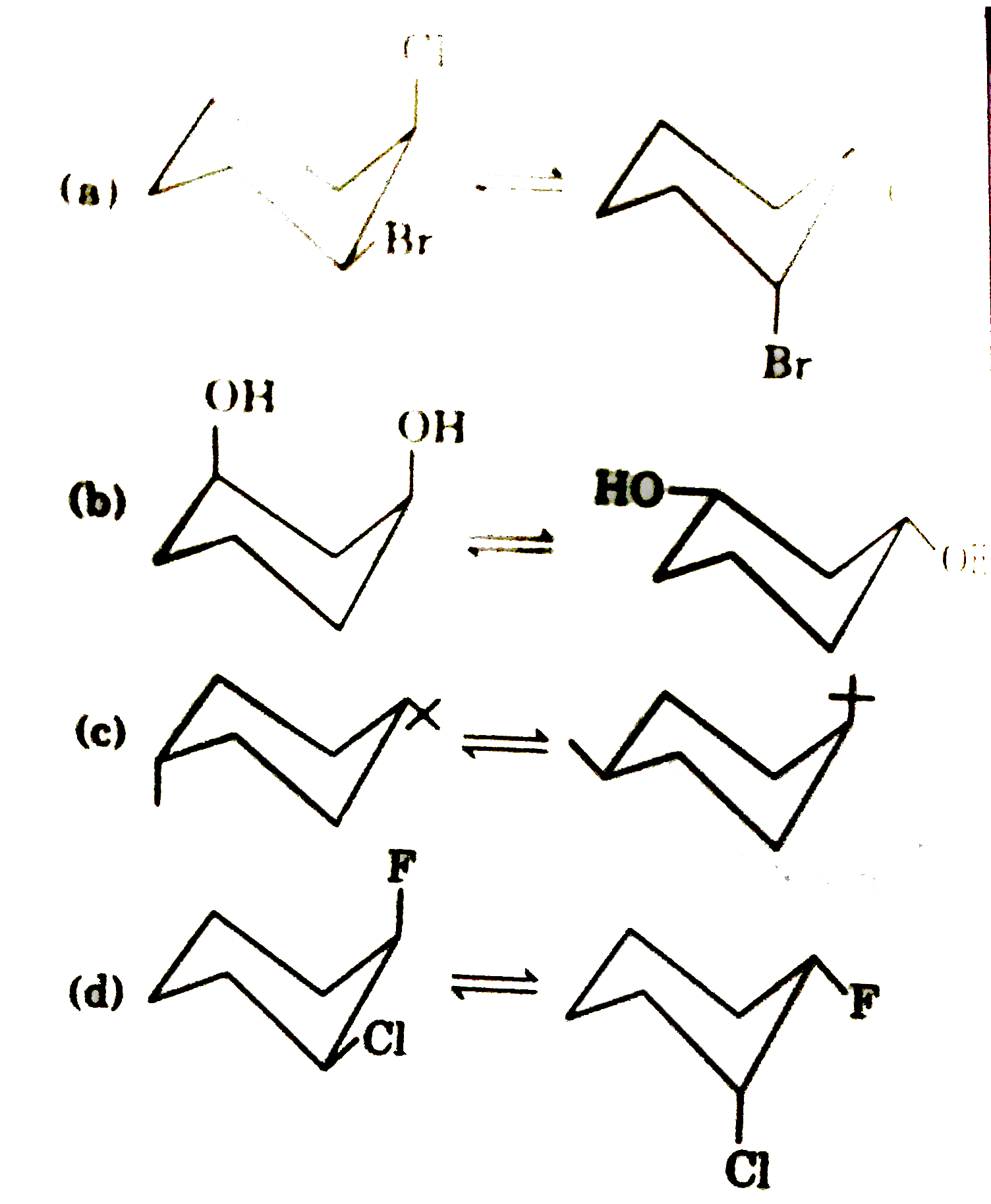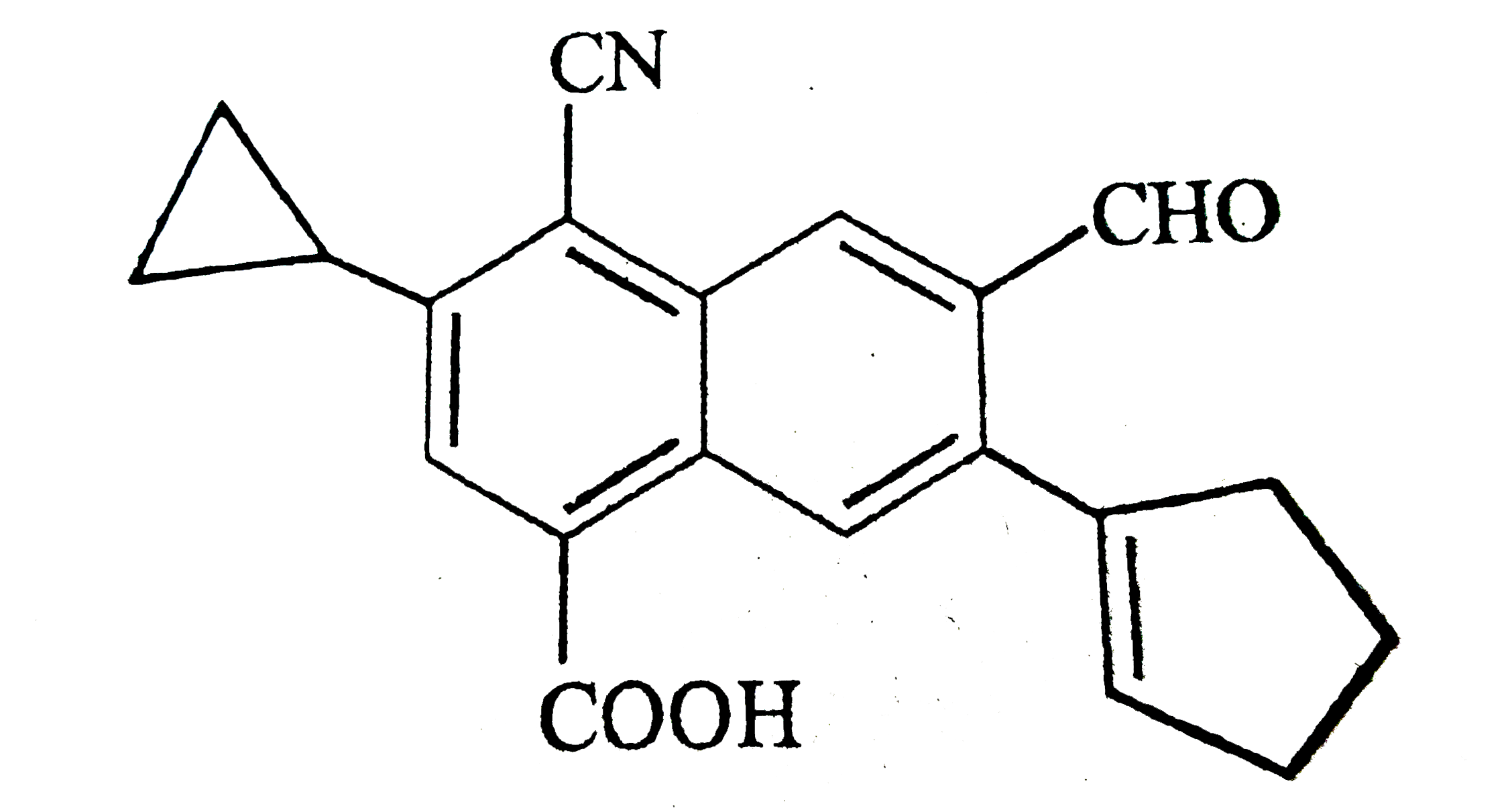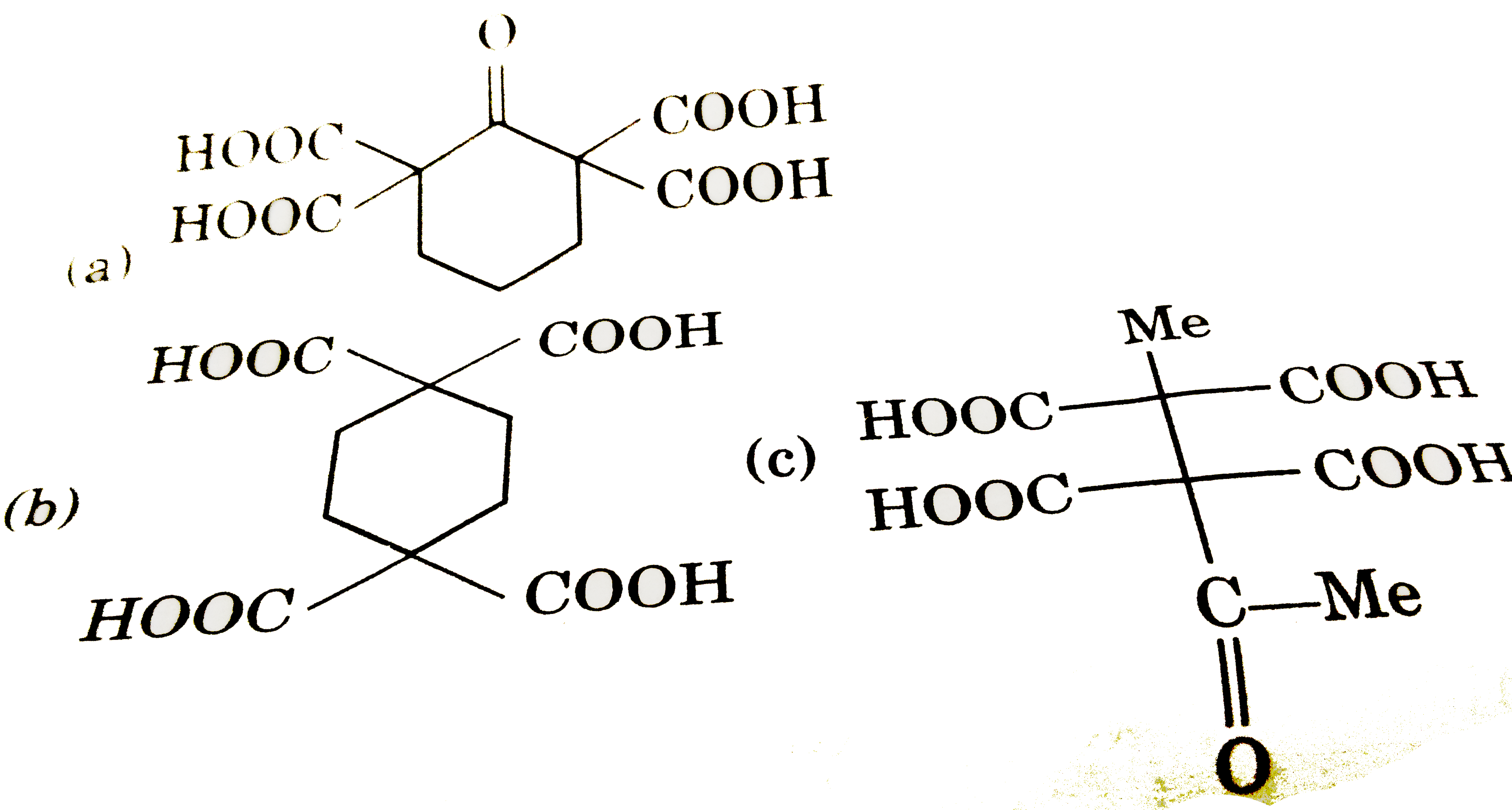Fill 1 in OMR sheet if the eequilibrium is favorred in forward direction and fall 2 in OMR sheet if the equilibrium is favoured in backward direction for example if all the eqilibrium are favoured in forward dirtection fill 1111 as anewer, and if olny first two are favoured in forward direcftion fill 1122 in OMR sheet.

The correct Answer is:1222
Topper's Solved these Questions
- ISOMERISMBOOK - GRB PUBLICATIONCHAPTER - ISOMERISMEXERCISE - MATCH THE COLUMN TYPE
22 Videos
- GASEOUS STATEBOOK - GRB PUBLICATIONCHAPTER - GASEOUS STATEEXERCISE - Exercise
530 Videos
- MOLE CONCEPT, STOICHIOMETRY & CONCENTRATION TERMSBOOK - GRB PUBLICATIONCHAPTER - MOLE CONCEPT, STOICHIOMETRY & CONCENTRATION TERMSEXERCISE - Subjective type
145 Videos
Similar Questions
Degree of unsaturation for following structure is 'x' then
 Fill x2 in OMR sheet
Fill x2 in OMR sheet
View SolutionIf a system at equilibrium is subjected to a change of any one of the factors such as concentration , pressure or temperature, the system adjusts itself in such a way so as to minimise the effect of that change.
Effect of change in concentration on equilibrium:
As we add or remove reactant (or product) the ratio of equilibrium concentratio become 'Q' (reaction quotient) and depending upon.
Q<K: equilibrium will shift ihn forward direction
Q>K equilibrium will shift in backward direction
Effect of change in pressure :
If a system in equilibrium consists of gases, then the concentrations of all the components can be altered by changing the pressure. When the pressure on the system is increased, then equilibrium will shift in the direction in which there is decrease in number of moles i.e., towards the direction in which there is decrease in volume.
Effect of change in pressure on melting point : There are two rypes of solids :
Solids whose volume decreases on melting, e.g., ice, diamond, carborundum, magnesium nitride and quartz.
Solid (higher volume) ⇔ Liquid (higher volume)
The process of melting is facillitated at high pressure, thus melting point is lowered.
Solid whose volume increase on melting, e.g., Fe, Cu, Ag, Au, etc.
Solid (lower volume) ⇔ Liquid (higher volume)
In this case the process of melring becomes difficult at high pressure, thuse melting point becomes high.
Solubility of substances : When solid substance are dissolved in water, either heat is evolved.
for endothermic solubility process solubility increase with increase in temperature. For exothemic solubility decrease with increase in temperature.
Solubility of gases in liquids : when a gas dissolves in liquid, there is decreases in voolume. Thus increase of pressure will faavour the dissolution of gas in liquid.
Effect of temperature : For endotherimic reacrtion as temperature increases reaction shift in backward direction
For the reaction
N2(g)+O2(g)⇔2NO(g)
If pressure id increased by reducing the volume of the container then :
View Solution
Knowledge Check
Mass action ratio or reaction quotient Q for a reaction can be calculated using the law of mass actionl,
A(g)+B(g)⇔C(g)+D(g)
Q=[C][D][A][B]
The value of Q decides whether the reaction is at equilibrium or not.
At equilibrium, Q=K
For non-equilibrium process Q≠K
When Q>K, reaction will be favoured in backward direction and when Q<K, it will be favoured in forward direction.
In the following reaction :
2SO2(g)+O2(g)⇔2SO3(g)
The equilibrium is not attained. The rate of forward reaction is greater than that of backward reaction. Thus, which of the following is the correct relation between Kp and Qp?AKp=QpBQp<KpCQp<KpDKp=Qp=1Mass action ratio or reaction quotient Q for a reaction can be calculated using the law of mass actionl,
A(g)+B(g)⇔C(g)+D(g)
Q=[C][D][A][B]
The value of Q decides whether the reaction is at equilibrium or not.
At equilibrium, Q=K
For non-equilibrium process Q≠K
When Q>K, reaction will be favoured in backward direction and when Q<K, it will be favoured in forward direction. For the reaction : 2A+B⇔3C at 298 K, Kc=49 A 3 L vessel contains 2, 1 and 3 moles of A, B and C respectively. The reaction at the same temperature :Amust proceed in forward direction.Bmust proceed in back directionCmust be predictedDcannot be predictedMass action ratio or reaction quotient Q for a reaction can be calculated using the law of mass actionl,
A(g)+B(g)⇔C(g)+D(g)
Q=[C][D][A][B]
The value of Q decides whether the reaction is at equilibrium or not.
At equilibrium, Q=K
For non-equilibrium process Q≠K
When Q>K, reaction will be favoured in backward direction and when Q<K, it will be favoured in forward direction. In a reaction mixture containing H2,N2 and NH3 at partial pressure of 2 atm, 1 atm and 3 atm respectively, the value of Kp at 725 K is 4.28×10−5 atm−2. In which direction the net reaction will go ?
N2(g)+3H2(g)⇔2NH3(g)AForwardBBackwardCNo net reactionDDirection cannot be predicated
Mass action rato or reaction quotient Q for a reaction can be calculate using the law of masss action
A(g)+B(g)⇔C(g)+D(g)
Q=[C][D][A][B]
The value of Q decides whether the reaction is at equilibrium or not.
At equilibrium, Q=K
For an equilibrium process, Q≠K
when Q>K, reaction will favour backward direction and when Q<K, it will favour forward direction.
Answer the following questions:
In a reaction mixture containing H2,N2 and NH3 at partial pressure of 2 atm, 1 atm and 3 atm respectively, the value of Kp at 700K is 4.00×10−5atm−2. In which direction the net reaction will go?
N2(g)+3H2(g)⇔2NH3(g)
View SolutionWrite the number of CO2 molecule :
For example if all are releasing one CO2 molecule fill 1111 in OMR sheet

View SolutionLe chatelier's principle
If a system at equilibrium is subjected to a change of any one of the factors such as concentration, pressure or temperature, the system adjusts itself in such a way so as to minimise the effect of that change. Change of pressure: If a system in equilibrium consists of gases, then the concentrations of all the components can be altered by changing the pressure.When the pressure on the system is increased, the volume decreases proportionately.The total number of moles per unit volume will now be more and the equilibrium will shift in the direction in which there is decrease in number of moles i.e., towards the direction in which there is decrease in volume.
Effect of pressure on melting point : There are two types of solids :
(a)Solids whose volume decreases on melting e.g. ice, diamond , carborundum, magnesium nitride and quartz.
Solid (higher volume)⇔ Liquid (lower volume)
The process of melting is facilitated at high pressure, thus melting point is lowered.
(b)Solids whose volume increase on melting, e.g. Fe,Cu, Ag,Au, etc.
Solid (lower volume)⇔ Liquid (higher volume)
In this case the process of melting becomes difficult at high pressure, then melting point becomes high.
(c )Solubility of subtances : When solid substance are dissolved in water, either heat is evolved (exothermic) or heat is absorbed (endothermic).
KCl+aq⇔KCl(aq)-heat
In such cases,solubility increase with increase in temperature.
Consider the case of KOH, when this is dissolved heat is evolved.
KOH+aq⇔KOH(aq)+heat
In such cases, solubility decrease with increase in temperature.
(d)Solubility of gases in liquids : When a gas dissolves in liquid, there is decreases in volume. Thus, increases of pressure will favour the dissolution of gas in liquid.
Effect of temperature: Le-Chatelier's principle predicts a system at equilibrium will tend to shift in the endothermic direction when temperature is raised, for then energy is absorbed as heat and the rise in temperature is opposed.Conversely, an equilibrium will shift in the exothermic direction if the temperature is lowered, for then energy is released and the reduction in temperture is opposed Van't Hoff equation shows the dependence of equilibrium constant K on temperaure as :
ddTlnK=ΔH∘RT2orlnK=constant−ΔH∘R.1T
Au(s)⇔Au(l)
View SolutionLe chatelier's principle
If a system at equilibrium is subjected to a change of any one of the factors such as concentration, pressure or temperature, the system adjusts itself in such a way so as to minimise the effect of that change. Change of pressure: If a system in equilibrium consists of gases, then the concentrations of all the components can be altered by changing the pressure.When the pressure on the system is increased, the volume decreases proportionately.The total number of moles per unit volume will now be more and the equilibrium will shift in the direction in which there is decrease in number of moles i.e., towards the direction in which there is decrease in volume.
Effect of pressure on melting point : There are two types of solids :
(a)Solids whose volume decreases on melting e.g. ice, diamond , carborundum, magnesium nitride and quartz.
Solid (higher volume)⇔ Liquid (lower volume)
The process of melting is facilitated at high pressure, thus melting point is lowered.
(b)Solids whose volume increase on melting, e.g. Fe,Cu, Ag,Au, etc.
Solid (lower volume)⇔ Liquid (higher volume)
In this case the process of melting becomes difficult at high pressure, then melting point becomes high.
(c )Solubility of subtances : When solid substance are dissolved in water, either heat is evolved (exothermic) or heat is absorbed (endothermic).
KCl+aq⇔KCl(aq)-heat
In such cases,solubility increase with increase in temperature.
Consider the case of KOH, when this is dissolved heat is evolved.
KOH+aq⇔KOH(aq)+heat
In such cases, solubility decrease with increase in temperature.
(d)Solubility of gases in liquids : When a gas dissolves in liquid, there is decreases in volume. Thus, increases of pressure will favour the dissolution of gas in liquid.
Effect of temperature: Le-Chatelier's principle predicts a system at equilibrium will tend to shift in the endothermic direction when temperature is raised, for then energy is absorbed as heat and the rise in temperature is opposed.Conversely, an equilibrium will shift in the exothermic direction if the temperature is lowered, for then energy is released and the reduction in temperture is opposed Van't Hoff equation shows the dependence of equilibrium constant K on temperaure as :
ddTlnK=ΔH∘RT2orlnK=constant−ΔH∘R.1T
For the reaction 12N2(g)+12O2(g)⇔NO(g)
View SolutionLe chatelier's principle
If a system at equilibrium is subjected to a change of any one of the factors such as concentration, pressure or temperature, the system adjusts itself in such a way so as to minimise the effect of that change. Change of pressure: If a system in equilibrium consists of gases, then the concentrations of all the components can be altered by changing the pressure.When the pressure on the system is increased, the volume decreases proportionately.The total number of moles per unit volume will now be more and the equilibrium will shift in the direction in which there is decrease in number of moles i.e., towards the direction in which there is decrease in volume.
Effect of pressure on melting point : There are two types of solids :
(a)Solids whose volume decreases on melting e.g. ice, diamond , carborundum, magnesium nitride and quartz.
Solid (higher volume)⇔ Liquid (lower volume)
The process of melting is facilitated at high pressure, thus melting point is lowered.
(b)Solids whose volume increase on melting, e.g. Fe,Cu, Ag,Au, etc.
Solid (lower volume)⇔ Liquid (higher volume)
In this case the process of melting becomes difficult at high pressure, then melting point becomes high.
(c )Solubility of subtances : When solid substance are dissolved in water, either heat is evolved (exothermic) or heat is absorbed (endothermic).
KCl+aq⇔KCl(aq)-heat
In such cases,solubility increase with increase in temperature.
Consider the case of KOH, when this is dissolved heat is evolved.
KOH+aq⇔KOH(aq)+heat
In such cases, solubility decrease with increase in temperature.
(d)Solubility of gases in liquids : When a gas dissolves in liquid, there is decreases in volume. Thus, increases of pressure will favour the dissolution of gas in liquid.
Effect of temperature: Le-Chatelier's principle predicts a system at equilibrium will tend to shift in the endothermic direction when temperature is raised, for then energy is absorbed as heat and the rise in temperature is opposed.Conversely, an equilibrium will shift in the exothermic direction if the temperature is lowered, for then energy is released and the reduction in temperture is opposed Van't Hoff equation shows the dependence of equilibrium constant K on temperaure as :
ddTlnK=ΔH∘RT2orlnK=constant−ΔH∘R.1T
The plot of log K against 1T is a straight line with positive slope ( K being the equilibrium constant of a reaction ), which of the following is then correct ?
View Solution
